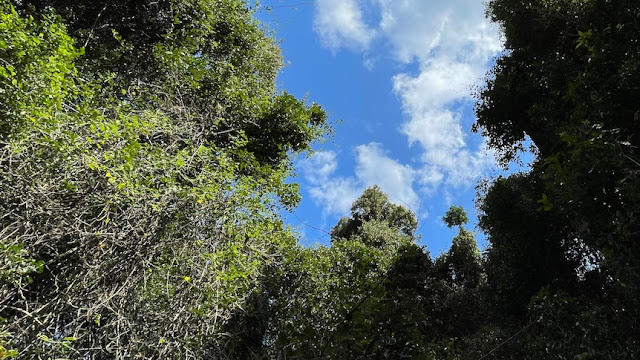Specialist teams target invasive weed taking over Lamington National Park since 2019 bushfires
Specialist teams target invasive weed taking over Lamington National Park since 2019 bushfires
They're armed and dangerous – if you're a weed that is.
Brandishing machetes, specialist environmental teams scale the mountainsides of Lamington National Park, ridding it of weeds that have taken over since the 2019 bushfires.
https://shangchielaleggendadeidiecianelli2021streamingita.talentlms.com/index
https://lescobayes2021streamingvfcompletgratuit.talentlms.com/index
https://regarderlescobayes2021completstreamingvf.talentlms.com/index
The fire that tore through two years ago today, burnt holes in the rainforest canopy, allowing light in – something weeds love.
The painstaking work to slash back the invasive pests is giving the World Heritage-listed rainforest a chance to recover and regrow.
Rosalinde Brinkman from the water catchment management group, Watergum, says the weeding program is vital.
"Through assisted regeneration, we try to help the forest establish [itself] quicker," she said.
The aim is to help the canopy to grow over and shut out the light that is letting weeds thrive.
https://regarderrouge2021filmstreaming.talentlms.com/index
https://rouge2021streamingvfgratuit.talentlms.com/index
Federal funding running out
Paul Donatiu's organisation, Healthy Land and Waterways, also runs weed eradication programs funded by the federal government.
Speaking in the Illinbah fire grounds, he explained the importance of the subset of forest.
"There's less than 10 per cent of this rainforest community left in the world," he said.
"So in terms of preserving and protecting this patch of rainforest, it's absolutely vital."
His teams are doing hard, long work in difficult conditions.
https://delorpourleschiens2021filmstreamingvfgratuit.talentlms.com/index
https://regarderdelorpourleschiensenstreamingvfgratuit.talentlms.com/index
While ridding the undergrowth of weeds, they are working among dangerous, but ecologically important, "stingers" whose leaves deliver a shock worse than a Blue Bottle jellyfish sting.
All around there's evidence of the scars left behind by the fires: scorched tree trunks, fallen burnt logs and stumps hollowed out by fire.
"So in this area, in particular, we see quite a bit of damage to parts of the lowland subtropical rainforests," Mr Donatiu said.
"Some areas were retained, others were really scorched and damaged, and they're the areas that we focused our restoration effort," he said.
But he said there's still a lot more work to be done once federal funding runs out.
"We probably need at least a three- to four-year timeframe of restoration activity, to be able to get something that even approaches a canopy that can start to exclude weeds," Mr Donatiu said.
In a statement, Queensland Environment Minister Meaghan Scanlon disputed the federal government's contribution.
"The federal government only contributes $90,000 per year to support the Gondwana world heritage-listed area," she said.
"The federal government has only made a one-off funding contribution post-bushfire that'll run out this financial year."
The minister did not respond to a specific question about what the state government's budget for weed eradication was, and did not answer a question about whether the government would fund the weed eradication needed, as identified in the new research.
Instead she pointed to the state's overall budget for park management.
"In just the last two years, the Palaszczuk government alone has invested more than $8 million towards the management of national parks on the Gold Coast," the statement said.
"That funding is used for weed management, control of pest animals, bushfire preparation and recovery, and the deployment of rangers to manage these areas."
The Conservation Council said the state government spent $35 million upgrading the road to Binna Burra.
"It's all very well … but perhaps we could match that with funding to look after the natural and cultural values of the national park as well," Andrew Picone said.
https://cro-moto.net/advert/%e2%96%b7%e4%b9%8b%e5%90%8e3-%e2%96%b7%e5%ae%8c%e6%95
$42 million needed over 10 years
The Queensland Conservation Council had commissioned research into how much restorative weeding still needed to be done in the Gondwana Rainforests of Main Range, Mt Barney, Springbrook and Lamington National Park.
"By our estimates — and this could be conservative — we've calculated about $42 million over 10 years needs to go into restoring the rain forest … [that's] just in the Queensland section of the Gondwana Rainforests, World Heritage Area," the Council's Andrew Picone said.
There has been some investment from the federal government, but less than $2 million has gone towards weeding.
That's less than a twentieth of what the Conservation Council says is needed.
"We haven't seen any matching funding come from the Queensland government, from the Palaszczuk government, which is a bit disappointing," Mr Picone said.
"What we really need to be doing is investing in these ecosystems to make sure that they can keep surviving an ever-increasing fire risk."
Mr Picone said the rain forests' heritage values needed to be protected.
"These national parks are World Heritage listed; they are internationally significant for a whole range of reasons," he said.
One of those reasons is the money that they contribute to the economy.
Mr Picone said the Gold Coast Hinterland National Parks accounted for $400 million in visitor spending each year.
"That equates to about 3,000 direct and indirect jobs, so tourism is a key part of this region's economy," Mr Picone said.
"Visiting National Parks is going to be central to our economic recovery [from COVID-19], so that's where we need to really invest a lot of our funding."
'Desperately important'
Local resident Lisa Groom's family has long links to Lamington National Park.
Her grandfather was a founder of Binna Burra Lodge, which was destroyed in the 2019 bushfire.
As the fire tore up through the valley, she watched as hoop pines exploded into flames.
Her family home was also destroyed.
"It's two years now and you can still see the damage quite strongly in certain places," she said.
"The weeds have come back big time."
Want more local news?
The Queenslander sign in the NSW-Queensland border town of Wallangarra in Queensland on October 8, 2020.
We offer tailored front pages for local audiences in each state and territory. Find out how to opt in for more Queensland news.
Read more
She said more needed to be done to protect the rainforest.
"[It's] desperately important, I think because to me, if we don't get on top of this, we've lost one of our biggest natural assets in Queensland," she says.
Rosalinde Brinkman from Watergum agreed.
"It's very important for the rainforest to recover because there are a lot of threatened and endangered species in this rain forest; in Lamington National Park," Ms Brinkman said.
Mr Donatiu said something as simple as weeding was needed, to allow the canopy to grow over and recover.
"So once we reach that point, yes, we can probably start to think about walking away," he said.
But that, he said, was years away.
Climate change is not some far-off problem
During January of 2020, I remember very clearly standing on Birchgrove Oval, arguably one of the most picturesque grounds in Australia, nestled in an enclave of Sydney Harbour. I was there to play a game for my local club, Sydney Cricket Club.
Sydney at that point in the summer was choking on smoke haze, the sky was burnt orange and you could barely see the outfield, let alone the surrounding harbour. It rained silt as we attempted to play.
For so many of us, and for so many generations of Australians, a game of cricket has been a quintessential part of our Aussie summer.
But thinking back on that game, with the smoke and ash, I wonder what kind of Australia we are headed for.
Beyond my own experience on the field, the images and stories of people and places that were left devastated during the 2019-20 bushfires had a profound effect on me.
Seeing people lose their homes, their farms, and, tragically for some, their loved ones was devastating. Not to mention the millions of hectares burnt out and the toll it took on communities, wildlife, and our emergency services.
That summer was a tangible experience that highlighted the consequences of climate change.
The worsening of impacts of extreme weather, like drought, flooding, heat waves and bush fires are something that impacts all of us, no matter where we live.
We can see it with our own eyes now, not as a far-off problem for someone else to deal with. It's left me deeply concerned about where we are and what's ahead.
That first-hand experience of what climate change will do to our country has been brought home even more as my partner Leah and I await the arrival of our first child in October.
Getting ready to have our first baby has really got my thinking beyond myself.
I'm concerned about the world we're going to leave for our children to grow up in.
I find myself thinking about what kind of legacy that will be.
Are we making a big enough effort to address climate change?
What will his life look like in 50 years? And what has been my role in that?
That's why I've chosen to use what voice I have to stand up and say, I want better.
For my son, for my family, for my community, and for the generations of young cricketers who will come after me.
I want to be part of making sure that the future we're building is one where we can keep the people and places we love safe.
I want to make sure, when my son is old enough to hold a bat, summer cricket is still something we can all enjoy.
Rachael Haynes is vice-captain of the Southern Stars national cricket team.




Komentar
Posting Komentar